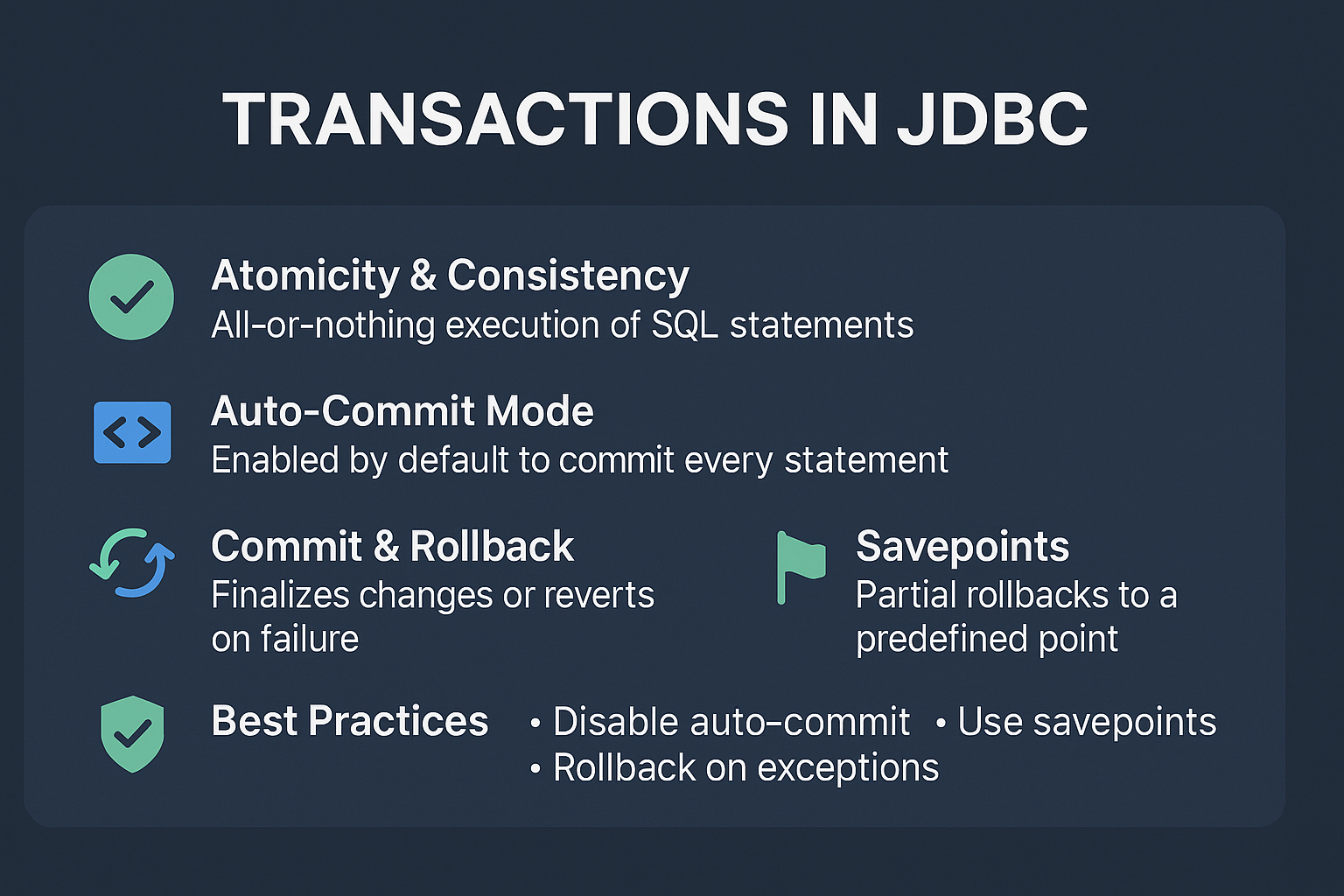Introduction
Transactions in JDBC allow multiple SQL statements to be executed as a single unit of work. If any statement in the transaction fails, all changes are rolled back to ensure data consistency. This is crucial for applications where maintaining data integrity is a top priority.
Why Transactions Matter
- Data Integrity: Ensures atomicity (all-or-nothing execution).
- Consistency: Keeps database state reliable even during failures.
- Critical for Financial and Enterprise Systems: Banking, e-commerce, and ERP rely heavily on transactions.
Core Concepts of JDBC Transactions
- Auto-Commit Mode: By default, every SQL statement is committed automatically.
- Manual Commit: Allows grouping multiple statements into a transaction.
- Rollback: Reverts changes if any statement fails.
- Savepoints: Allows partial rollbacks within a transaction.
Transaction Workflow
Java App → Connection → SQL Statements → Commit/Rollback → Database
Real-World Use Cases
- Banking: Transferring money between accounts.
- E-commerce: Processing orders and updating stock atomically.
- Data Migration: Ensuring all records are inserted or none at all.
- Enterprise Apps: Handling complex workflows with multiple SQL statements.
Implementing Transactions in JDBC
Basic Example
import java.sql.*;
public class TransactionExample {
public static void main(String[] args) {
String url = "jdbc:mysql://localhost:3306/testdb";
String user = "root";
String password = "password";
try (Connection conn = DriverManager.getConnection(url, user, password)) {
conn.setAutoCommit(false); // Start transaction
try (Statement stmt = conn.createStatement()) {
stmt.executeUpdate("UPDATE accounts SET balance = balance - 500 WHERE id = 1");
stmt.executeUpdate("UPDATE accounts SET balance = balance + 500 WHERE id = 2");
conn.commit(); // Commit transaction
System.out.println("Transaction committed successfully.");
} catch (SQLException e) {
conn.rollback(); // Rollback if any statement fails
System.out.println("Transaction rolled back due to error.");
e.printStackTrace();
}
} catch (SQLException e) {
e.printStackTrace();
}
}
}
Using Savepoints
try {
conn.setAutoCommit(false);
Savepoint savepoint1 = conn.setSavepoint("Step1");
stmt.executeUpdate("INSERT INTO orders (id, amount) VALUES (1, 100)");
Savepoint savepoint2 = conn.setSavepoint("Step2");
stmt.executeUpdate("INSERT INTO payments (id, amount) VALUES (1, 100)");
conn.commit();
} catch (SQLException e) {
conn.rollback(savepoint1); // Rollback to first savepoint
}
Statement vs PreparedStatement in Transactions
| Feature | Statement | PreparedStatement |
|---|---|---|
| SQL Injection Safety | Vulnerable | Safe with parameter binding |
| Performance | Re-parsed each execution | Precompiled, faster for reuse |
| Best Use | Static queries | Dynamic and parameterized queries |
Common Mistakes and Anti-Patterns
- Leaving Auto-Commit Enabled: Prevents grouping statements into transactions.
- Not Handling Exceptions: Failing to rollback on errors leads to inconsistent data.
- Mixing Business Logic and Transactions: Keep transaction management separate.
- Long Transactions: Holding locks for too long reduces concurrency.
Security Implications
- Always validate user input even inside transactions.
- Use least privilege DB accounts to reduce damage potential.
- Combine with PreparedStatement to avoid SQL injection.
Performance and Scalability
- Use transactions for logical units of work only.
- Keep transactions short to avoid blocking other queries.
- Use connection pooling with proper transaction isolation levels.
Best Practices
- Disable auto-commit before starting a transaction.
- Always rollback on exceptions.
- Use savepoints for complex transactions.
- Combine transactions with PreparedStatement for security.
Real-World Analogy
Think of a JDBC transaction as a shopping cart checkout. You add multiple items (SQL statements) to the cart. Only when you pay (commit) does the purchase go through. If something goes wrong, you cancel (rollback) the entire order.
Conclusion & Key Takeaways
- Transactions ensure data integrity with all-or-nothing execution.
- Use manual commit and rollback for complex workflows.
- Combine with PreparedStatement for secure, scalable systems.
FAQ
-
What is a transaction in JDBC?
A sequence of SQL statements executed as a single unit of work. -
Why disable auto-commit?
To group multiple statements into one transaction. -
What is rollback in JDBC?
Reverts all changes made during the transaction. -
What are savepoints?
Points within a transaction to which you can roll back partially. -
Is transaction management database-specific?
JDBC provides a standard API; behavior depends on database isolation levels. -
How to handle nested transactions in JDBC?
Use savepoints; JDBC does not support true nested transactions. -
Does transaction impact performance?
Short transactions are fine; long ones can reduce concurrency. -
Can I mix SELECT and UPDATE in a transaction?
Yes, any SQL statements can be grouped in a transaction. -
Is transaction management required in all apps?
Essential for apps where data consistency is critical. -
Which is better: Statement or PreparedStatement for transactions?
PreparedStatement for security and performance with dynamic queries.
